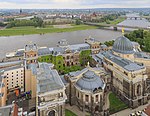Innere Neustadt (Dresden)
Boroughs and quarters of DresdenDresdenHistoric districts in Germany

The Innere Neustadt (Inner New City) is a neighborhood in Dresden within the administrative district of Neustadt. The name is derived from "Neue Königliche Stadt" (New Royal City), the name given to the former district of Altendresden when it was rebuilt after a fire before 1732. In contrast to the Äußere Neustadt (Outer New City), the Innere Neustadt was within the city fortifications and, for that reason, is also known as the historic Neustadt. Its population is 7,761 (2020).
Excerpt from the Wikipedia article Innere Neustadt (Dresden) (License: CC BY-SA 3.0, Authors, Images).Innere Neustadt (Dresden)
Neustädter Markt, Dresden Innere Neustadt (Neustadt)
Geographical coordinates (GPS) Address Nearby Places Show on map
Geographical coordinates (GPS)
| Latitude | Longitude |
|---|---|
| N 51.058333333333 ° | E 13.741666666667 ° |
Address
Nymphenbrunnen I
Neustädter Markt
01097 Dresden, Innere Neustadt (Neustadt)
Saxony, Germany
Open on Google Maps










